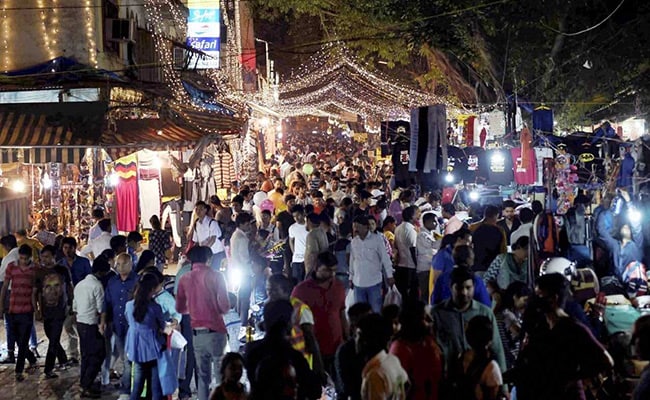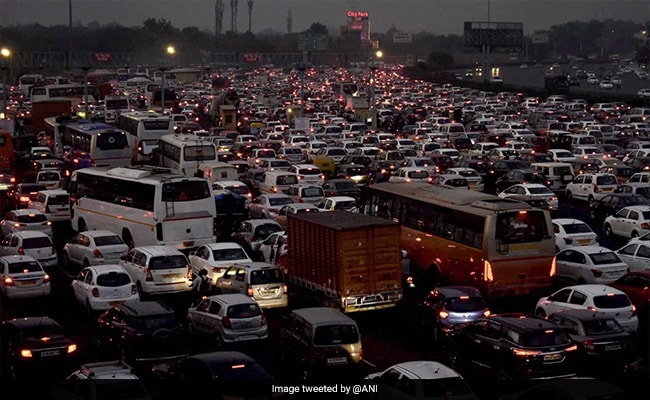Delhi's air quality was closely-watched amid a ban on sale of firecrackers, ordered by the Supreme Court
New Delhi:
A quiet and promising evening gave way to thick haze and noise as Delhi celebrated Diwali on Thursday, dashing the hopes of cracker-free festivities, following a Supreme Court ban on the sale of firecrackers in the National Capital Region (NCR).
The online indicators of the pollution monitoring stations in the city glowed red, indicating a 'very poor' air quality as the volume of ultra fine particulates PM2.5 and PM10, which enter the respiratory system and manage to reach the bloodstream, sharply rose from around 7 pm.
However, the air quality in Delhi during Diwali was better than last year, according to a data from the Central Pollution Control Board (CPCB). The Air Quality Index (AQI) value on Thursday was 319, putting it in "very poor" category, while the AQI last Diwali (October 30) had touched "severe" level after recording an index value of 431.
AQI level from 0-50 is considered good, 51-100 is satisfactory, 101-200 is moderate, 201-300 is poor, 301-400 is very poor, and 401 and above is severe.
 Real time pollution data appeared alarming. The Delhi Pollution Control Committee's (DPCC) RK Puram monitoring station recorded PM2.5 and PM10 at 878 and 1,179 micrograms per cubic metre at around 11 pm.
Real time pollution data appeared alarming. The Delhi Pollution Control Committee's (DPCC) RK Puram monitoring station recorded PM2.5 and PM10 at 878 and 1,179 micrograms per cubic metre at around 11 pm.
The pollutants had violated the corresponding 24-hour safe limits of 60 and 100 respectively by up to 10 times.
While it is difficult to quantify the immediate effect of the ban on firecrackers, residents across the national capital felt the beginning was promising with neighbourhoods reporting much lesser noise and smoke till about 6 pm, compared to the previous years.
But as the festivities picked up, the faint echo of crackers started growing louder.
According to the SAFAR (System of Air Quality and Weather Forecasting And Research), the 24-hour rolling average of PM2.5 and PM10 were 154 and 256 micrograms per cubic metre respectively at around 11 pm.
It has forecast that the pollution levels will peak between 11 pm and 3 am.
 The situation was similar, if not worse, in the neighbouring regions of Delhi such as Gurgaon, Noida and Ghaziabad, where crackers were burst as usual, raising question marks on the efficacy of the administration in enforcing the apex court's ban.
The situation was similar, if not worse, in the neighbouring regions of Delhi such as Gurgaon, Noida and Ghaziabad, where crackers were burst as usual, raising question marks on the efficacy of the administration in enforcing the apex court's ban.
However, the SAFAR has also predicted a relatively cleaner post-Diwali air due to favourable meteorological conditions, which are helping prevent the smoke-filled air from the agricultural belt of Haryana and Punjab from entering the national capital.
A 'very poor' air quality index (AQI) essentially means that people may suffer from respiratory illnesses on a prolonged exposure to such air. If the air quality dips further, the AQI will turn 'severe', which may trouble even those with sound health conditions and seriously affect those with ailments.
The Supreme Court-appointed Environment Pollution Prevention and Control Authority (EPCA) is empowered to enforce the Graded Response Action Plan (GRAP) to combat air pollution in Delhi-NCR.
Measures under the GRAP's 'very poor' and 'severe' categories, which include a ban on diesel generator sets, came into effect on October 17 and they will remain in force till March 15.
The online indicators of the pollution monitoring stations in the city glowed red, indicating a 'very poor' air quality as the volume of ultra fine particulates PM2.5 and PM10, which enter the respiratory system and manage to reach the bloodstream, sharply rose from around 7 pm.
However, the air quality in Delhi during Diwali was better than last year, according to a data from the Central Pollution Control Board (CPCB). The Air Quality Index (AQI) value on Thursday was 319, putting it in "very poor" category, while the AQI last Diwali (October 30) had touched "severe" level after recording an index value of 431.
AQI level from 0-50 is considered good, 51-100 is satisfactory, 101-200 is moderate, 201-300 is poor, 301-400 is very poor, and 401 and above is severe.

The effect of a ban on sale of crackers in Delhi wore down later into the night.
The pollutants had violated the corresponding 24-hour safe limits of 60 and 100 respectively by up to 10 times.
While it is difficult to quantify the immediate effect of the ban on firecrackers, residents across the national capital felt the beginning was promising with neighbourhoods reporting much lesser noise and smoke till about 6 pm, compared to the previous years.
But as the festivities picked up, the faint echo of crackers started growing louder.
According to the SAFAR (System of Air Quality and Weather Forecasting And Research), the 24-hour rolling average of PM2.5 and PM10 were 154 and 256 micrograms per cubic metre respectively at around 11 pm.
It has forecast that the pollution levels will peak between 11 pm and 3 am.

Pollution metrics were similar, if not worse, in the neighbouring regions of Delhi such as Gurgaon..
However, the SAFAR has also predicted a relatively cleaner post-Diwali air due to favourable meteorological conditions, which are helping prevent the smoke-filled air from the agricultural belt of Haryana and Punjab from entering the national capital.
A 'very poor' air quality index (AQI) essentially means that people may suffer from respiratory illnesses on a prolonged exposure to such air. If the air quality dips further, the AQI will turn 'severe', which may trouble even those with sound health conditions and seriously affect those with ailments.
The Supreme Court-appointed Environment Pollution Prevention and Control Authority (EPCA) is empowered to enforce the Graded Response Action Plan (GRAP) to combat air pollution in Delhi-NCR.
Measures under the GRAP's 'very poor' and 'severe' categories, which include a ban on diesel generator sets, came into effect on October 17 and they will remain in force till March 15.
Track Latest News Live on NDTV.com and get news updates from India and around the world

